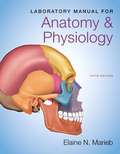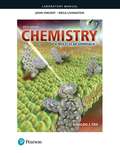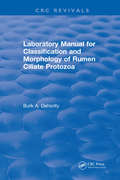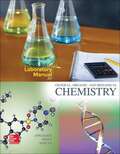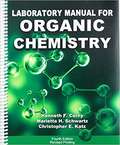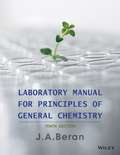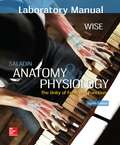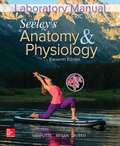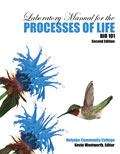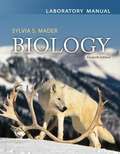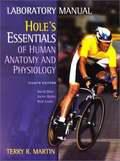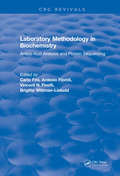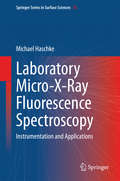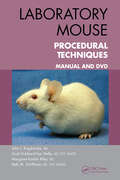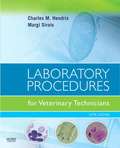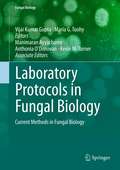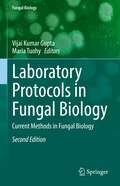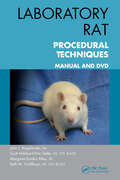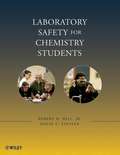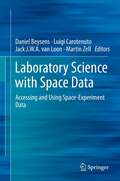- Table View
- List View
Laboratory Manual for Anatomy & Physiology (Fifth Edition)
by Elaine N. MariebThis laboratory manual is designed for instructors who teach a two-semester introductory anatomy & physiology course, but do not require the full range of laboratory exercises found in Marieb’s best-selling Human Anatomy & Physiology Lab Manuals (Cat, Fetal Pig, and Main).
Laboratory Manual for Biotechnology and Laboratory Science: The Basics, Revised Edition
by Lisa A. Seidman Mary Ellen Kraus Diana Lietzke Brandner Jeanette MoweryProvides the basic laboratory skills and knowledge to pursue a career in biotechnology. Written by four biotechnology instructors with over 20 years of teaching experience, it incorporates instruction, exercises, and laboratory activities that the authors have been using and perfecting for years. These exercises and activities help students understand the fundamentals of working in a biotechnology laboratory. Building skills through an organized and systematic presentation of materials, procedures, and tasks, the manual explores overarching themes that relate to all biotechnology workplaces including forensic, clinical, quality control, environmental, and other testing laboratories.Features:• Provides clear instructions and step-by-step exercises to make learning the material easier for students. There are Lab Notes for Instructors in the Support Material (see tab below).• Emphasizes fundamental laboratory skills that prepare students for the industry.• Builds students’ skills through an organized and systematic presentation of materials, procedures, and tasks.• Updates reflect recent innovations and regulatory requirements to ensure students stay up to date.• Supplies skills suitable for careers in forensic, clinical, quality control, environmental, and other testing laboratories.
Laboratory Manual for Chemistry: A Molecular Approach
by John Vincent Nivaldo Tro Erica LivingstonUpdated for the new edition of Chemistry: A Molecular Approach, this manual contains twenty-nine experiments with a focus on real world applications. Each experiment contains a set of pre-laboratory questions, an introduction, a step-by-step procedure (including safety information and a report section featuring post-laboratory questions). Additional features include a section on laboratory safety rules, an overview on general techniques and equipment, as well as a detailed tutorial on graphing data in Excel.
Laboratory Manual for Classification and Morphology of Rumen Ciliate Protozoa
by B.A. DehorityThe only rumen protozoa lab guide featuring line drawings created by a leading scientist in the fieldLaboratory Manual for Classification and Morphology of Rumen Ciliate Protozoa is a unique lab guide for learning how to count and identify rumen protozoa. In this guide, Professor Dehority has created line drawings of rumen protozoa that emphasize morphological features and size measurements. The book also provides keys for identifying genera and species, and it contains classifications and descriptions of the different orders and families of rumen ciliate protozoa. Procedures for counting rumen protozoa and identifying individual species are included as well.Laboratory Manual for Classification and Morphology of Rumen Ciliate Protozoa will be an excellent identification guide for protozoologists, microbiologists, dairy scientists, and any researcher or student working with rumen protozoa.
Laboratory Manual for General, Organic, and Biological Chemistry
by Cindy Applegate Mary Bethe Neely Michael SakutaThe Laboratory Manual for General, Organic, and Biological Chemistry by Applegate, Neely, and Sakuta was authored to be the most current lab manual available for the GOB market, incorporating the most modern instrumentation and techniques. Illustrations and chemical structures were developed by the authors to conform to the most recent IUPAC conventions. A problem solving methodology is also utilized throughout the laboratory exercises. The Laboratory Manual for General, Organic, and Biological Chemistry by Applegate, Neely, and Sakuta is also designed with flexibility in mind to meet the differing lengths of GOB courses and variety of instrumentation available in GOB labs. Helpful instructor materials are also available on this companion website, including answers, solution recipes, best practices with common student issues and TA advice, sample syllabi, and a calculation sheet for the Density lab.
Laboratory Manual for Organic Chemistry
by Kenneth F Cerny Marietta H Schwartz Christopher E KatzThis new manual takes students of organic chemistry through a multitude of basic laboratory techniques such as reaction setup, reflux, distillation, recrystallization, thin layer chromatography and many others. Modern spectroscopic techniques such as UV-Vis, FT-IR, and NMR are reviewed and utilized as a part of many experiments. As with all editions of this manual, the authors include pre-laboratory hand-in assignments and post experiment study questions.
Laboratory Manual for Principles of General Chemistry (Tenth Edition)
by Jo Allan BeranPre-laboratory Assignment Questions emphasize the chemical principles presented in the introduction of the experiment. Representative calculations, data analysis, and points of emphasis required for the completion of the Experimental Procedure are also addressed in the Pre-laboratory Assignment. ?h Laboratory Questions help promote a deeper understanding of the experiment and help students recognize where chemical principles can be used for interpreting unexpected data or ?turning points? in the experiment. In-depth discussion of lab techniques and easy-to-reference techniques icons: Lab techniques are covered in the front of the manual and are assigned an icon. The icons are placed in the margin of the text at the appropriate point at which to use the technique. ?h Safety and Disposal Icons: Icons contained in the Experimental Procedures indicate safety cautions and provide information regarding the correct disposal of test solutions. Strong coverage/emphasis on safety. Illustrations and clear procedures make it a good reference for students. Offers Dry Labs that can be done outside the lab setting. Offers easy custom pub options. Extensive background information offered within each lab. Can be used with any text.
Laboratory Manual for Saladin's Anatomy & Physiology
by Eric WiseWritten by Eric Wise of Santa Barbara City College, this comprehensive manual contains 41 laboratory exercises that are integrated closely with the Saladin Anatomy and Physiology textbook. Each exercise demonstrates key anatomical and physiological facts and principles presented in Anatomy and Physiology by directing students to investigate specific concepts in greater detail.
Laboratory Manual for Seeley's Anatomy and Physiology (11th Edition)
by Eric WiseLaboratory Manual For Seeley's Anatomy And Physiology, Eleventh Edition
Laboratory Manual for the Processes of Life: Bio 101, Second Edition
by Kevin WentworthHolyoke Community College Lab Manual for Bio 101
Laboratory Manual to Accompany Introductory D.C/ A.C. Electronics (Fourth Edition) and Introductory DC/AC Circuits (Fourth Edition)
by Nigel P. Cook Gary Lancaster Hugh ScrivenLaboratory Manual to Accompany INTRODUCTORY DC/AC ELECTRONICS and INTRODUCTORY DC/AC CIRCUITS
Laboratory Manual to Accompany Introductory D.C/ A.C. Electronics (Fourth Edition) and Introductory DC/AC Circuits (Fourth Edition)
by Nigel P. Cook Gary Lancaster Hugh ScrivenLaboratory Manual to Accompany INTRODUCTORY DC/AC ELECTRONICS and INTRODUCTORY DC/AC CIRCUITS
Laboratory Manual to accompany Biology, Eleventh Edition
by Sylvia S. MaderThis manual helps students learn the fundamental concepts of biology and the specific content of the chapter to which the lab relates, and to gain a better understanding of the scientific method.
Laboratory Manual: Hole's Essentials of Human Anatomy and Physiology
by Terry R. MartinThis laboratory manual is designed for students with minimal backgrounds in the physical and biological sciences who are pursuing careers in allied health fields.
Laboratory Methodology in Biochemistry: Amino Acid Analysis and Protein Sequencing
by Carlo FiniProvides information on methodologies and techniques concerning the biochemical laboratory, as well as improvements or advancements made on existing methodologies. Original methodologies for the purification of biological macromolecules and methodologies for metabolic pathways and enzyme kinetics are covered. The application of biochemical and biophysical methodologies for the structural and dynamic characterization of biological macromolecules is considered. The elaboration of automated systems for biochemical research and computer programs for the management and processing of experimental data are both reviewed. Development of instruments and equipment for biochemical research is also presented.
Laboratory Micro-X-Ray Fluorescence Spectroscopy
by Michael HaschkeMicro-X-ray fluorescence offers the possibility for a position- sensitive and non-destructive analysis that can be used for the analysis of non-homogeneous materials and layer systems. This analytical technique has shown a dynamic development in the last 15 years and is used for the analysis of small particles, inclusions, of elemental distributions for a wide range of different applications both in research and quality control. The first experiments were performed on synchrotrons but there is a requirement for laboratory instruments which offers a fast and immediate access for analytical results. The book discuss the main components of a µ-XRF instrument and the different measurement modes, it gives an overview about the various instruments types, considers the special requirements for quantification of non-homogeneous materials and presents a wide range of application for single point and multi-point analysis as well as for distribution analysis in one, two and three dimensions.
Laboratory Mouse Procedural Techniques: Manual and DVD
by John J. Bogdanske Scott Hubbard-Van Stelle Margaret Rankin Riley Beth SchiffmanThis combination manual and DVD provides much-needed training on the proper handling of mice used in biomedical research. The DVD includes narrated video clips that demonstrate and describe each procedural technique. The manual contains handouts with color illustrations and descriptive text for each technique, including the purpose and application
Laboratory Pathology Words and Phrases
by Sally Crenshaw PitmanBook useful for medical transcriptionists. Includes laboratory terminology, tables of bones, muscles, nerves and more.
Laboratory Procedures for Veterinary Technicians (5th edition)
by Charles M. Hendrix Margi SiroisFive American academics contribute nine chapters to an updated text for practicing veterinary technicians, veterinary assistants, and veterinary technology students. The text covers principles and procedures for laboratory diagnostics in the areas of clinical chemistry, microbiology, hematology, homeostasis, parasitology, urinalysis, immunology, and cytology. It assumes a basic understanding of the anatomy and physiology of common species. The new edition has been significantly updated with expanded information reflecting the latest developments in the veterinary clinical laboratory since publication of the 2002 edition. It includes new sections on laboratory mathematics, hematopoiesis, molecular diagnostics, and the physiologic basis of immunity; expanded information on clinical analyzers and quality assurance; and information on professional associations related to veterinary clinical pathology. Illustrated with full color and b&w photomicrographs, charts, and diagrams. Annotation ©2008 Book News, Inc., Portland, OR (booknews.com)
Laboratory Protocols in Fungal Biology
by Maria G. Tuohy Anthonia O’donovan Vijai Kumar Gupta Kevin M. Turner Manimaran AyyachamyLaboratory Protocols in Fungal Biology presents the latest techniques in fungal biology. This book analyzes information derived through real experiments, and focuses on cutting edge techniques in the field. The book comprises 57 chapters contributed from internationally recognised scientists and researchers. Experts in the field have provided up-to-date protocols covering a range of frequently used methods in fungal biology. Almost all important methods available in the area of fungal biology viz. taxonomic keys in fungi; histopathological and microscopy techniques; proteomics methods; genomics methods; industrial applications and related techniques; and bioinformatics tools in fungi are covered and complied in one book. Chapters include introductions to their respective topics, list of the necessary materials and reagents, step-by-step, readily reproducible laboratory protocols, and notes on troubleshooting. Each chapter is self-contained and written in a style that enables the reader to progress from elementary concepts to advanced research techniques. Laboratory Protocols in Fungal Biology is a valuable tool for both beginner research workers and experienced professionals.
Laboratory Protocols in Fungal Biology: Current Methods in Fungal Biology (Fungal Biology)
by Vijai Kumar Gupta Maria TuohyMycology has an integral role to play in the development of the biotechnology and biomedical sectors. It has become a subject of increasing importance as new fungi and their associated biomolecules are identified. As this discipline comes to the forefront of research in these sectors, the requirement for a consolidation of available research approaches is required. The First Edition of this book has a few basic and applied protocols. With the Second Edition, this book provides consolidated information on recent developments and the most widely used mycological methods available in the fields of biochemistry, biotechnology and microbiology. The methods outlined offer clear and concise directions to the reader and covers both standard protocols and more applied mycological methods. This book provides useful information for undergraduates, post-graduates, and specialists and researchers studying fungal biology.
Laboratory Rat Procedural Techniques: Manual and DVD
by John J. Bogdanske Scott Hubbard-Van Stelle Margaret Rankin Riley Beth SchiffmanThis combination manual and downloadable resources provide much-needed training on the proper handling of rats used in biomedical research. The downloadable resources include narrated video clips that demonstrate and describe each procedural technique. The manual contains handouts with color illustrations and descriptive text for each technique, including the purpose and application of the procedure, recommended skills, and necessary supplies. It can be used as a training resource and refresher for lab animal veterinarians, veterinary technicians, animal care staff, trainers, and research investigators and staff who work with rats.
Laboratory Safety for Chemistry Students
by Robert H. Hill Jr. David C. FinsterProvides knowledge and models of good practice needed by students to work safely in the laboratory as they progress through four years of undergraduate laboratory work Aligns with the revised safety instruction requirements from the ACS Committee on Professional Training 2015 "Guidelines and Evaluation Procedures for Bachelor's Degree Programs" Provides a systematic approach to incorporating safety and health into the chemistry curriculum Topics are divided into layers of progressively more advanced and appropriate safety issues so that some topics are covered 2-3 times, at increasing levels of depth Develops a strong safety ethic by continuous reinforcement of safety; to recognize, assess, and manage laboratory hazards; and to plan for response to laboratory emergencies Covers a thorough exposure to chemical health and safety so that students will have the proper education and training when they enter the workforce or graduate school
Laboratory Safety for Chemistry Students
by Robert H. Hill David Finster"...this substantial and engaging text offers a wealth of practical (in every sense of the word) advice...Every undergraduate laboratory, and, ideally, every undergraduate chemist, should have a copy of what is by some distance the best book I have seen on safety in the undergraduate laboratory." Chemistry World, March 2011Laboratory Safety for Chemistry Students is uniquely designed to accompany students throughout their four-year undergraduate education and beyond, progressively teaching them the skills and knowledge they need to learn their science and stay safe while working in any lab. This new principles-based approach treats lab safety as a distinct, essential discipline of chemistry, enabling you to instill and sustain a culture of safety among students. As students progress through the text, they'll learn about laboratory and chemical hazards, about routes of exposure, about ways to manage these hazards, and about handling common laboratory emergencies. Most importantly, they'll learn that it is very possible to safely use hazardous chemicals in the laboratory by applying safety principles that prevent and minimize exposures.Continuously Reinforces and Builds Safety Knowledge and Safety CultureEach of the book's eight chapters is organized into three tiers of sections, with a variety of topics suited to beginning, intermediate, and advanced course levels. This enables your students to gather relevant safety information as they advance in their lab work. In some cases, individual topics are presented more than once, progressively building knowledge with new information that's appropriate at different levels.A Better, Easier Way to Teach and Learn Lab SafetyWe all know that safety is of the utmost importance; however, instructors continue to struggle with finding ways to incorporate safety into their curricula. Laboratory Safety for Chemistry Students is the ideal solution: Each section can be treated as a pre-lab assignment, enabling you to easily incorporate lab safety into all your lab courses without building in additional teaching time.Sections begin with a preview, a quote, and a brief description of a laboratory incident that illustrates the importance of the topic.References at the end of each section guide your students to the latest print and web resources.Students will also find "Chemical Connections" that illustrate how chemical principles apply to laboratory safety and "Special Topics" that amplify certain sections by exploring additional, relevant safety issues.Visit the companion site at http://userpages.wittenberg.edu/dfinster/LSCS/.
Laboratory Science with Space Data
by Martin Zell Luigi Carotenuto Jack J.W.A. van Loon Daniel BeysensFor decades experiments conducted on space stations like MIR and the ISS have been gathering data in many fields of research in the natural sciences, medicine and engineering. The EU-sponsored Ulisse Internet Portal provides metadata from space experiments of all kinds and links to the data. Complementary to the portal, this book will serve as handbook listing space experiments by type of infrastructure, area of research in the life and physical sciences, data type, what their mission was, what kind of data they have collected and how one can access this data through Ulisse for further research. The book will provide an overview of the wealth of space experiment data that can be used for research, and will inspire academics (e.g. those looking for topics for their PhD thesis) and research departments in companies for their continued development.
